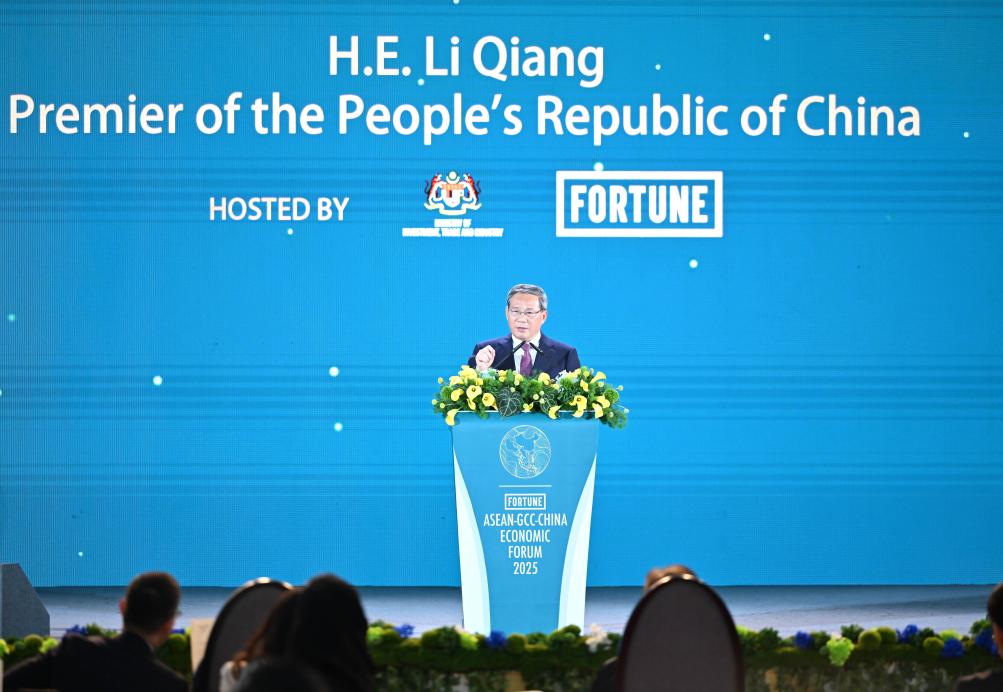
In an era defined by turbulence and transformation, China, as the largest developing nation, finds itself at a critical juncture, tasked with championing global development as it advances its modernization.
It is in this light that China's proposal, put forward by Premier Li Qiang at the recent landmark Association of Southeast Asian Nations-Gulf Cooperation Council-China Summit, should be viewed.
It is not merely a diplomatic overture for greater economic cooperation between the three sides, but an innovation in regional governance. It envisions Asia not as a loose collection of economies, but as a resilient, interdependent, and self-reinforcing ecosystem — a model in which cooperation reduces vulnerability to external shocks.
READ MORE: Li: Scope of trilateral ties 'boundless'
The proposal advocates for novel models of international industrial and economic collaboration. Premier Li's call for deepened strategic ties and cross-civilization integration with ASEAN and the GCC underscores China's commitment to foster partnerships grounded in mutual respect and equitable treatment, while navigating the rising tide of protectionism and unilateral trade measures.
ASEAN and the GCC, as influential economic blocs with global significance, comprise a diverse array of economies with immense potential. The 10 Southeast Asian nations along with observer states rank as the world's fifth-largest economy. The GCC, encompassing six Arab states bordering the Gulf, boasts the world's largest reserves of crude oil and natural gas, making it a powerhouse of energy resources.
China's envisioning of Asia as a resilient, interdependent economic ecosystem is both pragmatic and visionary. It underscores the fundamental truth of China's diplomatic thought that a stable and prosperous Asia serves as a linchpin for global stability.
By emphasizing a unified response to the attempts to foster global fragmentation in the joint statement they released after the summit, the three sides have made their nexus a cornerstone of regional stability and prosperity with economic cooperation focused on energy, technology and digital infrastructure — the drivers of region-wide prosperity. By fostering research collaboration, talent development and cross-border trade, the initiative lays the groundwork for a practical road map toward shared progress and regional resilience.
By highlighting the positive effects of China's growth, modernization and multilateral engagement, it provides an effective counter to the "China threat" narrative by demonstrating the "China opportunity" narrative. This is based not only on China's potential to contribute to shared prosperity but its ability to envision a global community with a shared future.
ALSO READ: Declaration to raise most dynamic model in Asia-Pacific cooperation to new heights
Efforts to foster the free flow of economic factors across borders, as exemplified by initiatives such as the Belt and Road Initiative and the ASEAN-GCC-China cooperation framework, aim to empower developing nations to ascend the value chain and participate meaningfully in the global economy. By providing stability, policy certainty, and non-interventionist development financing, China has emerged as a provider of global public goods, anchoring global economic governance amid uncertainty.
The ASEAN-GCC-China Summit represents more than a symbolic gathering — it signifies the dawn of a new era of interregional cooperation. As the framework develops, it will not only chart a new course for Asia, but also set a precedent for cross-regional collaboration grounded in diversity and mutual benefit.
By embracing the principles of mutual respect, cooperation and inclusivity, the core of the vision laid out by Premier Li at the summit lies in a simple truth: a stable and prosperous Asia is a stabilizer for the world.
It is expected that as the trilateral model of ASEAN-GCC-China cooperation continues to evolve, the three sides, sharing same or similar views on burning global issues, will also coordinate more closely on regional and international affairs and, in doing so, contribute to greater global stability.


